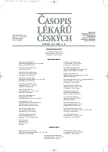Alternating Hemiplegia of Childhood (AHC)
Authors:
S. Nevšímalová; M. Havlová; A. Tauberová; I. Příhodová
Authors‘ workplace:
Neurologická klinika 1. LF UK a VFN, Praha
Published in:
Čas. Lék. čes. 2005; 144: 692-696
Category:
Original Article
Overview
Background.
Alternating hemiplegia of childhood (AHC) is a rare neurological disease of unknown aetiology characterized by recurrent paroxysmal attacks of side - alternating hemiplegias of variable duration associated withother paroxysmal dysfunctions. Paroxysmal attacks start in infants but neurological deficits become progressive with the age.
Methods and Results.
During the last 20 years 8 patients (5 boys, 3 girls) with AHC were followed. Mean age at the time of diagnosis was 2.75 years, age range 2–5 years; mean follow up period 13.9 years (range 1 month-20 years) The diagnosis was based on clinical history and neurological findings, completed by neurophysiological and neuroimaging methods (SPECT, PET), and results of psychological and biochemical findings. Paroxysmal phenomena (occulo-motor, tonic, choreo-athetotic, autonomic) appearing at the age of 4.1±2.2 months and followed by repeated attacks of hemiplegia (age onset 16.3±13.0 months) were the first symptoms. Progressive neurological impairment covering spasticity, dyskinetic syndrome, cerebellar ataxia and intellectual deficit was present in all cases, epileptic seizures in 7 out of 8 patients. On ictal SPECT/PET examination hypoperfusion/glucose hypometabolism were demonstrated above affected hemispheres including basal ganglia, both thalami and cerebellar hemispheres. Improvement of hemiparesis was illustrated by nocturnal videomonitoring.
Conclusions.
AHC is a chronic disease with progressive neurological deficit. A flunarizine therapy has a favorable effect on frequency and severity of paroxysmal attacks, but does not prevent a progressive neurological impairment.
Key words:
alternating hemiplegia, paroxysmal attacks, diagnosis, neuroimaging methods, video-polysomnography, long-term follow-up, prognosis, therapy.
Labels
Addictology Allergology and clinical immunology Angiology Audiology Clinical biochemistry Dermatology & STDs Paediatric gastroenterology Paediatric surgery Paediatric cardiology Paediatric neurology Paediatric ENT Paediatric psychiatry Paediatric rheumatology Diabetology Pharmacy Vascular surgery Pain management Dental HygienistArticle was published in
Journal of Czech Physicians

Most read in this issue
- Heart Rate Variability During Sleep
- Alternating Hemiplegia of Childhood (AHC)
- Intermittent Catheterization of Urinary Bladder – Indications, Technique, Complications
- Alcohol and Pregnancy
